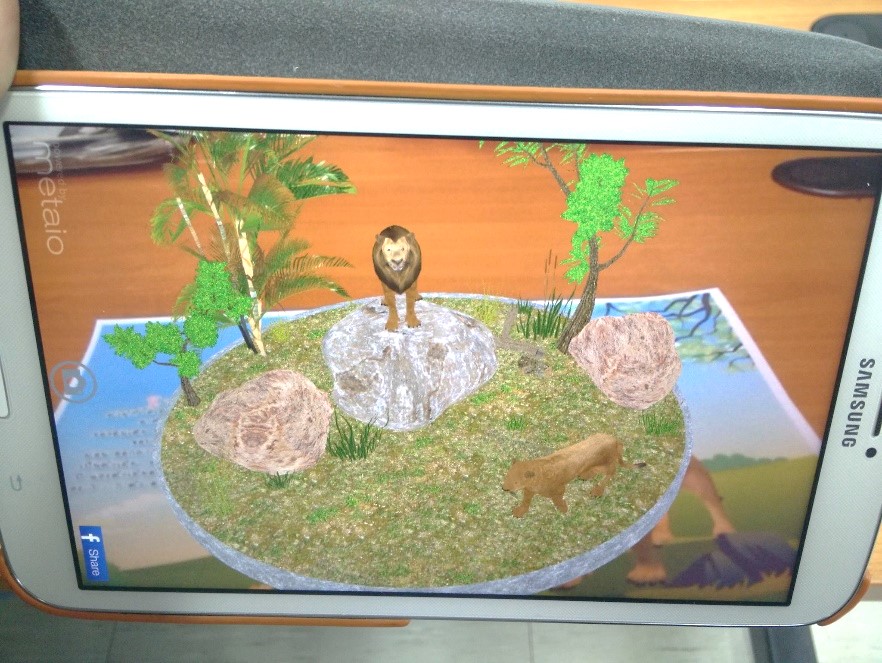การพัฒนาหนังสือสวนสัตว์สามมิติด้วยเทคโนโลยีโลกเสมือนผสานโลกจริงบนระบบปฏิบัติการแอนดรอยด์
Main Article Content
Abstract
Nadh Ditcharoen and Anupong Ratthirom
รับบทความ: 15 เมษายน 2559; ยอมรับตีพิมพ์: 31 พฤษภาคม 2559
บทคัดย่อ
บทความนี้มีวัตถุประสงค์เพื่อนำเสนอวิธีการออกแบบและพัฒนาหนังสือสวนสัตว์แบบสามมิติด้วยเทคโนโลยีโลกเสมือนผสานโลกจริง (Augmented Reality) ที่แสดงโมเดลแอนิเมชั่นสามมิติของสัตว์ใน 9 ส่วนการแสดงของสวนสัตว์อุบลราชธานีจำนวน 21 โมเดลใช้งานบนระบบปฏิบัติการแอนดรอยด์ การพัฒนาหนังสือสวนสัตว์สามมิติ ประกอบด้วย 6 ขั้นตอนหลัก ได้แก่ 1) การออกแบบและพัฒนาโมเดล 2) การออกแบบและพัฒนามาร์คเกอร์ 3) การสร้างเสียงประกอบ 4) การรวมองค์ประกอบ 5) การพัฒนาแอพพลิเคชั่น และ 6) การสร้างไฟล์ติดตั้ง หนังสือสวนสัตว์สามมิตินี้พัฒนาด้วยโปรแกรม Autodesk Maya โปรแกรม Adobe Photoshop โปรแกรม Metaio Creator และภาษา Arel Script โมเดลทั้งหมดได้รับการตรวจสอบความถูกต้องและปรับแก้จนสมบูรณ์ทั้งด้านเนื้อหาและด้านการพัฒนาสื่อจากผู้เชี่ยวชาญของสวนสัตว์อุบลราชธานีและผู้เชี่ยวชาญด้านเทคโนโลยี ผลการทดสอบระบบและการศึกษาความพึงพอใจด้วยแบบสอบถามจากผู้ใช้จำนวน 55 คน พบว่า ค่าเฉลี่ยความพึงพอใจมีค่าเท่ากับ 4.17 ซึ่งอยู่ในระดับดี หนังสือสวนสัตว์สามมิตินี้ช่วยให้จดจำสัตว์ได้ง่ายขึ้น อำนวยความสะดวกแก่ผู้ใช้งานในการศึกษาเกี่ยวกับสัตว์ได้ทุกที่ทุกเวลา ทั้งยังช่วยส่งเสริมการท่องเที่ยวไทยได้อีกทางหนึ่ง
คำสำคัญ: สื่อการเรียนรู้ หนังสือสามมิติ ระบบปฏิบัติการแอนดรอยด์ โลกเสมือนผสานโลกจริง
Abstract
This paper aimed to present the design and development of a three-dimension zoo book using augmented reality (AR) technology. The book was designed for running on an android device displaying 21 animation models of 9 animal show zones in Ubon Ratchathani Zoo. The design and development process comprised of 6 main modules: 1) the design and development of models, 2) the design and development of markers, 3) sound ripping and synthesis, 4) component integration, 5) the design and development of android application, and 6) application deployment. The 3D zoo book was developed using Autodesk Maya, Adobe Photoshop, Metaio Creator, and AREL Script. All 3D animations were examined and modified in terms of content, completeness and media development by experts of Ubon Ratchathani zoo and technological experts of Ubon Ratchathani University. The book and application was tested and evaluated by 55 users in terms of users’ satisfaction using the questionnaires. The results showed that the average of users’ satisfaction was 4.17 which was at the high level. This book can facilitate users in memorizing animals, learning about animals and their habitat anywhere anytime, as well as it can be an alternative way to promote tourism in Thailand.
Keywords: Learning media, 3D book, Android, Augmented reality, Lapak Ponsel
Downloads
Article Details

This work is licensed under a Creative Commons Attribution-NonCommercial 4.0 International License.
References
Ditcharoen, N., Polyiam, K., Vangkahad, P., and Jarujamrus, P. (2014). Development of learning media in topics of atomic structure and chemical bond with augmented reality technology. Journal of Research Unit on Science, Technology and Environment for Learning 5(1): 21–27. (in Thai)
Guideubon.com (2014). Ubon Ratchathani Zoo. Retrieved from http://guideubon.com/ news/view.php?t=26&s_id=10&d_id=10, June 10, 2014. (in Thai)
Kietseangtong, W., Prommart, P., and Chalermsakulkit, A. (2009). A study on Augmented Reality through a Case Study of Memcard Game Development. B.Sc. Senior project in Computer Science. Bangkok: Srinakharinwirot University. Retrieved from http://facstaff.swu.ac.th/pra ditm/CP 499_2552_AR.pdf, September 29, 2014. (in Thai)
Metaio.com (2014). Arel Script. Retrieved from https://dev.metaio.com/arel/overview/, September 27, 2014.
Metaio.com (2014). Metaio Creator. Retrieved from http://www.metaio.com/about/, September 25, 2014.
Promso, C., Saejueng, P., and Wuttisela, K. (2015). Study on normalized learning gains and concepts of molecular shape and polar covalent bond learning through augmented reality technology. Journal of Research Unit on Science, Technology and Environment for Learning 6(1): 57–69. (in Thai)
Sripromting, N., and Saelee, A. (2014). Kingdom of Virtual Animal.Retrieved from http://store.learnsquare.com/eserv/changeme:192/FullReport.pdf, September 29, 2014. (in Thai)
Tansiri, P. (2010). Augmented reality. Executive Journal 30(2): 169–175. (in Thai)
Thananuwong, R. (2013). Learning media of Buoyant force using augmented reality. IPST Magazine 41(181): 28–31. (in Thai)
Tiantong, M. (2005). Statistics and Research Methodology in Information Technology. Bangkok: King Mongkut’s University of Technology North Bangkok. (in Thai)
